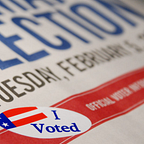California’s June 5th state election will determine winners or nominees, across several races, for California’s November general election.
How will June’s California election unfold?
It’s hard to say. This year, 18,854,829[1] Californian’s are registered to vote. But only 6 million, at best, are expected to turn in their ballots. Though elections officials hoped California would hit the 20 million registered voters mark, we didn’t pass the milestone. We are percentage wise, just where we were in 2013: 47% registered. [2]
According to the Los Angeles times, “No [California] gubernatorial primary has attracted even 35% of registered voters since 2002.” In 2014, turnout hit an all-time low of 25%. [3]
How will low voter turnout impact election results?
That’s also hard to gauge because there’s so much on the ballot. This year there are 27 candidates for governor and 32 for Senate. There are candidates for the State Assembly and for Congress. In addition to state items, voters will decide on local races like city councils and boards of supervisors. For some voters, primary elections will mean deciding between 131 candidates.
Pollsters are still unsure about how to poll given such large ballots. Use the full ballot? Poll on only certain candidates?
“I’ve never dealt with ballots like this,” said Ben Tulchin of San Francisco, who was Sen. Bernie Sanders’ pollster in the 2016 presidential campaign, “It’s crazy,” he told the SF Chronicle. [4]
Who is registered and who is most likely to turn in their ballot?
As far as age, the 66 and older age group has the highest percentage of registered voters at 20%. Comparatively, the 17.5–25 year olds have 11.9% voter registration rates. Every other age group falls in between this 11.9–20% registration range. [5]
Democrats make up nearly 45 percent of the total number of registered voters in the state. Republicans and those with No Party Preference each make up just slight over 25 percent. Every other political identification falls behind these three as far as numbers of registered voters. [6]
But no one knows who who will show up to vote.
From the New York Times: “If Republicans fall short in capturing one of those two November slots next month, which members of both parties say is a strong possibility, it would apparently be the first election since 1914 where a major party had no candidate in either the race for senator or for governor.” [7]
It is up to you, dear registered voter, to educate yourself on your ballot, turn in your ballot, nudge your friends to register, and to share the voting message. Use We Vote, the next generation digital voter guide to review what is on your ballot, review endorsements from people and groups you trust and seamlessly prepare your vote with confidence. Share We Vote with friends and give them the voter tools to become more savvy voters.
We Vote cuts through the clutter to help you understand what’s on your ballot. Our open platform empowers voters to create and share voter guides that aggregate information and opinions across personal networks. So you can help your friends be better voters too.
We Vote is made of two nonpartisan nonprofit organizations (501(c)(3) and 501(c)(4)) based in Oakland, California. Our software is open source, and our work is driven by the nearly 100 volunteers who have contributed so far. Inspired by groups like Code for America and the Mozilla Foundation, we use technology to make democracy stronger by increasing voter turnout. Through our nonpartisan, open source platform, we’ll help you become an informed voter, up and down the ballot.
Use We Vote to see your ballot and easily create a shareable digital voter guide informed by issues you care about, and people and organizations you trust.
Learn More: https://wevote.us/more/organization
Irene Florez is We Vote’s Marketing Manager.
